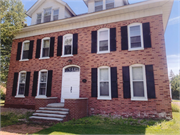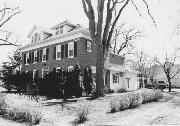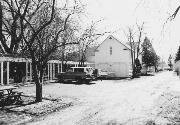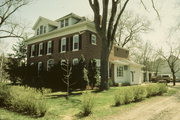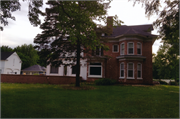| Additional Information: | This house is a two story brick veneer building. It is one of the few brick residences in New Richmond. Two front dormers have been added on to the hip roof. One dormer has a gable roof with a box cornice and a flat head Palladian window. To the west of this is a hip roof dormer. There is aluminum siding under the eaves and where brackets used to be. Windows have brick arched heads and shutters. Three windows on the front second story are on the oldest portion, with the entry and two windows below. To the west are two more windows on both floors of this newer section. The stoop porch front entry has an arched door head. First story front windows are 2/2. On the west side a small second story brick arched window is found. First story windows are multi-paned picture windows. On the east is a bay window.
Sanborn Maps show that as early as 1892 additions in the rear and porch alterations were done. Between 1912 and 1928, barns or/and carriage house was removed. Today a wood lattice walkway leads from the house to a two story detached carriagfe house. Clapboard is on the first story and board and batten on the second story. The roof is a center gable one with shingled returns. The plan is rectangular. There is a box cornice and plain frieze under the eaves. See SC 35-2 for photo. Landscaping consists of trees, evergreens and hedges, some hedges forming fences.
Thisn house has had many alterations and additions. BEcause of this it is not architecturally significant. It does fit in well in this neighborhood. As you enter this neighborhood from the eat along West First Street the scale of the building and property make an impressive first site as you enter this potential district.
Background
William J. Virgin built this residence in 1884d. The January 30, 1884 edition of the paper reported that Mr. Virgin was hauling materials for his home which would be brick veneer. Byn May, Mr. Kribs and Son were hired as contractors and the house was being built by May 28. On July 23, caqrpenters were in the house and on September 17, 1884, Mr. Virgin was in his house. The deck of the residence was said to have an iron cresting on October 8, 1884. It was not veneered immediately. 1887 news articles state that the house would be cream color3ed Milwaukee brick but the brick is red. It was built as a clapboard house and veneered by 1892. Photos of the back of th house after the 1899 tornado show clapboard where bricks have been torn off. It would seem that both a delay in bricking the home and change of bricks occured. The 1880 census shows that Virgin was born in England and was 34 years old at the time the census wsa taken. A flour miller, he was married to a 29 year old from Pennsylvania. They had two daughters aged 2 and 6. The six year old was "in school". Virgin bought the proeprty from Cragin and Jacobs, who owned the local lumber mill, on a $500.00 warranty deed in 1883. When the land wsa sold in 1888 the warranty deed was for $3,500.00 indicating some capital improvement. Sanborn map of 1887 shows a home here.
From 1889-1925, L.A. and Minnie Baker owned the house. Baker was the first cashier at the Manufacturers Bank. In 1910 Baker was 48 years old and had been married 22 years. Mrs. Baker was the daughter of John Glover (see industry, people and SC 20-19, 251 West Second)/. In 1919 he was an officer and director of the bank. The tornado of June 1899 damaged the SW corner of the house and the stables but the house survived. It was used as the headquarter of the relief committee and supply depot. Mr. Baker was the secretary of the Businessman's Association working on post tornado clean up.
An 1899 photo shows a brick italianate house with hip roof, arched windows and wrap around porch. There are brackets under the eave and turned wood porch columns. Three 2/2 windows are on the front second story. There are relief supplies all over the porch.
In 1925, Carleton Friday moved into this house. He had come to New Richmond to establish Friday Canning Corporation (with his father's assistance). The company still exists and is run by his son, who was born in the house (See SC 12, 13 and 20 for Friday Canning.) The corporation buys local produce, as well as growing its own and employs year round and extra seasonal help. The Friday Foundation is a philanthropy set up by the family to distribute monies locally. The family lived here until 1938.
At this time the New Richmond Roller Mills Co. ( now known as Domain and Doboy, a Divison of Nordson) bought the home to use as a corporate hotel for visitors and as office space. There was a lack of hotel rooms in New Richmond. The company was diversitying and expanding at this time. Flour is no longer milled here but feed is processed and packaging and plastics are a part of the company. (See SC31-8, 9 and 25 for Domain and Doboy.) In 1948, the company sold the house to William J. McNally. It became a single family residence again.
McNally was a WWI war correspondent, author, playwright and businessman. He founded the fine artsd group of New Richmond, an association to acquaint children with local arts. He died i 1968 and the house stayed in the family until recently (see chapter on important persons for information on the McNally family).
Significance
The house has local significance because of its pivotal role as the relief headquarters and supply depot after the 1899 tornado. The tornado destroyed or damaged all of the business district and 200 or more homes. About 150 were injured and 119 killed in this city of approximately 2,000 people. Estimated property loss was over $623,000.00. During the obviously critical stage in the city's rebuilding the residence was probably the most important building left, h ousing supplies nad providing space to plan New Richmone's immediate future develdopment.
This house also has local significance because of its association with Carleton Friday. It was the residence he lived in when he was establishing the Friday CAnning Company. This company is the second largest employer in the city (after Doboy and Domain) and also provides income for local farmers, buying their produce. |
|---|
| Bibliographic References: | A. Oral History of Mrs. C.A. Friday at Friday Memorial Library.
B. Property Abstract, Lent by Owner, Newspaper September 17, 1884.
C. August 11, 1899 "Republican Voice"
D. 100+5 Edition of "The News".
E. Sanborn Maps, 1887, 1892, 1912, 1927.
F. A Modern Herculaneum: The Story of the New Richmond Tornado.
G. Anna Epley, 1900. Photo at Friday Memorial Library.
New Richmond News 1/23/1997.
New Richmond Walking Tour brochure, 2000. |
|---|

